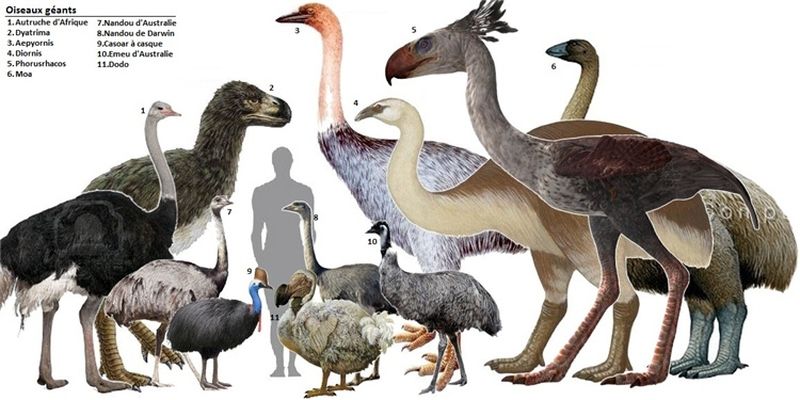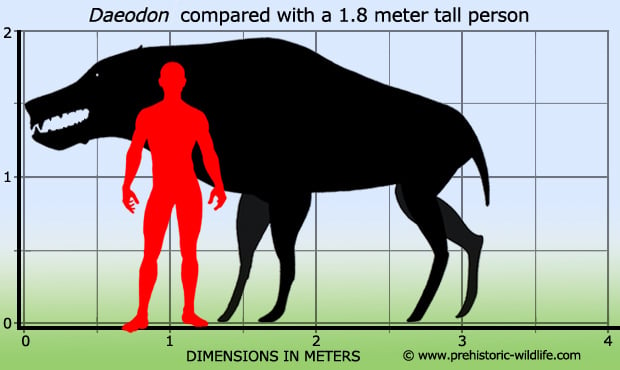|
|
Post by Joey12 on Jul 31, 2021 2:11:48 GMT
Looking at the tail more alligator than whale.
|
|
|
|
Post by Talira Greycrest on Jul 31, 2021 10:07:39 GMT
Name: LibycosaurusPronunciation: Lib-e-co-sore-us.Meaning of name: "Libya lizard"Species: L. anisae, L. petrocchiiSize: 3 metres long.Family: AnthracotheriidaeDiet: HerbivoreFirst fossils found: Known from several partial skeletons discovered throughout northern and central Africa. L. petrocchii named in 1947. L. anisae named in 1972.Lived: Depending on species, lived between 23.03 and 5.332 million years ago from the Aquitanian stage of the Early Miocene through to the Zanclean stage of the Early Pliocene in what is now northern and central Africa. L. petrocchii jawbone L. petrocchii jawbone
|
|
|
|
Post by Joey12 on Aug 1, 2021 6:36:53 GMT
Looks like a herbivore.
|
|
|
|
Post by Talira Greycrest on Aug 1, 2021 9:50:37 GMT
Name: Nambashag
Pronunciation: Nam-bah-shak
Meaning of name: Named after the Namba Formation of South Australia where its fossils were discovered.
Species: N. billerooensis, N. microglaucus
Wingspan: Uncertain
Family: Phalacrocoracidae
Diet: Piscivore
First fossils found: Known from several specimens discovered in the Namba and Etadunna Formations of South Australia. Both species named by Trevor H. Worthy in 2011.
Lived: 26 to 24 million years ago during the Chattian stage of the Late Oligocene in what is now South Australia.
Unfortunately, I was unable to find any pictures of this prehistoric bird.
|
|
|
|
Post by Joey12 on Aug 1, 2021 10:02:24 GMT
Well maybe it's in this group. Or a relative of the group.  |
|
|
|
Post by Talira Greycrest on Aug 1, 2021 11:55:18 GMT
I looked up the family that Nambashag belongs to and it's the same family that modern Cormorants belong to. Therefore, I'm assuming Nambashag was an early Cormorant.
|
|
Tix Mascot
Tech guru
Italy is my second homeland
Posts: 11,097  Mini-Profile Background: {"image":"http://4.bp.blogspot.com/-X5mhw13BJ7Y/TwKeZ3uM7YI/AAAAAAAABPw/D82go4Ny_8E/s1600/italy-background-8-787281.jpg","color":""}
Mini-Profile Text Color: 0ef8f1
Mini-Profile Name Color: f40d39
Year of Birth: 1961
Nationality: Norwegian
Mini-Profile Background: {"image":"http://4.bp.blogspot.com/-X5mhw13BJ7Y/TwKeZ3uM7YI/AAAAAAAABPw/D82go4Ny_8E/s1600/italy-background-8-787281.jpg","color":""}
Mini-Profile Text Color: 0ef8f1
Mini-Profile Name Color: f40d39
Year of Birth: 1961
Nationality: Norwegian
|
Post by Tix Mascot on Aug 1, 2021 12:23:21 GMT
Cool!  |
|
|
|
Post by Joey12 on Aug 2, 2021 4:23:52 GMT
Wonder how many families of animals died out.
|
|
|
|
Post by Talira Greycrest on Aug 2, 2021 8:43:26 GMT
Name: DaeodonPronunciation: Day-oh-donMeaning of name: "Hostile tooth"Species: D. shoshonensisSize: 3.6 metres long, 2 metres tall and weighing almost 100kgs.Family: Entelodontidae.Diet: Carnivore/omnivoreFirst fossils found: Known from several specimens discovered in the western United States. Named by American palaeontologist, Edward Drinker Cope in 1879.Lived: 23 to 20 million years ago from during the Aquitanian and Burdigalian stages of the Early Miocene in what is now the western United States.

|
|
|
|
Post by Joey12 on Aug 2, 2021 10:47:03 GMT
Looks like a really tall wild boar.
|
|
Tix Mascot
Tech guru
Italy is my second homeland
Posts: 11,097  Mini-Profile Background: {"image":"http://4.bp.blogspot.com/-X5mhw13BJ7Y/TwKeZ3uM7YI/AAAAAAAABPw/D82go4Ny_8E/s1600/italy-background-8-787281.jpg","color":""}
Mini-Profile Text Color: 0ef8f1
Mini-Profile Name Color: f40d39
Year of Birth: 1961
Nationality: Norwegian
Mini-Profile Background: {"image":"http://4.bp.blogspot.com/-X5mhw13BJ7Y/TwKeZ3uM7YI/AAAAAAAABPw/D82go4Ny_8E/s1600/italy-background-8-787281.jpg","color":""}
Mini-Profile Text Color: 0ef8f1
Mini-Profile Name Color: f40d39
Year of Birth: 1961
Nationality: Norwegian
|
Post by Tix Mascot on Aug 2, 2021 17:39:30 GMT
Wonder how many families of animals died out. Probably a combination of climate changes, predators and lack of food. Talira Greycrest surely knows more. Looks like a really tall wild boar. Something I would prefer to not meet while running through the forest. Poisonous snakes are more than enough for me. I've already encountered two so far this year.. |
|
|
|
Post by Joey12 on Aug 3, 2021 5:48:16 GMT
Just a standard wild boar I think you would want to avoid also but this big guy would be great for a pig roast.
|
|
|
|
Post by Talira Greycrest on Aug 3, 2021 8:34:50 GMT
It's estimated that over 99% of all plants and animals that have ever lived are now extinct. That's around five billion species. Notable extinct species include golden toads, thylacines, saber-toothed cats, dodos, trilobites, ground sloths, mammoths and non-avian dinosaurs.
There are many different things that can cause animals and plants to go extinct including genetic pollution, habitat destruction, predation, disease and climate change. Also, throughout Earth's 4.5 billion year history, there have been at least five mass extinctions. The largest of these was the Permian-Triassic extinction, around 250 million years ago, which is estimated to have killed 90% of species then existing.
|
|
|
|
Post by Joey12 on Aug 3, 2021 9:04:35 GMT
And now as the oceans warm up again will we be next.
|
|
|
|
Post by Talira Greycrest on Aug 3, 2021 10:05:29 GMT
The Holocene extinction, sometimes called the sixth mass extinction or the Anthropocene extinction, is an ongoing extinction event being caused by human activity. Modern humans have only existed for around 300,000 years, yet our impact on this planet has been huge.
|
|